Dispelling some common market myths
Myths abound. Is a bubble forming in shares? How long will the reflation trade last? Are we in a new mining super cycle? Is it over for technology and growth shares? All good questions that I will try and answer.
While the broader share market has been grinding higher in recent months, beneath the surface we have seen a meaningful rotation out of defensive shares into cyclical parts of the share market. As long-term interest rates have started backing up again, we are also seeing a change of leadership out of growth securities back into value.
By midway through last year, the first COVID wave had passed, and activity was picking up quickly. The reflation trade was on, and the US dollar fell while risk assets and commodities rallied with the promise of recovery. This shift out of defensive shares that benefited from COVID into cyclical sectors was the primary market trend of last year.
In the depths of the crisis, as capital shifted into the safety of bonds and central banks pumped liquidity into capital markets, real bond yields turned negative in most countries. All asset classes are priced relative to the risk-free sovereign bond. The value of growth shares is very sensitive to movements in this discount rate, particularly those that are loss making with the promise of future profits (think of Tesla TLSA:US). Most of these growth names reside within the technology sector. They benefited further from the health crisis, as businesses everywhere were forced into the digital age. Technology, the largest sector in the US share market, was pivotal to the turnaround in shares last year as it became clear these companies were benefiting from the crisis.
While the health crisis was the icing on the cake, these companies had performed well in recent years as real interest rates had fallen across advanced economies. The 30-year bull market in bonds (and the associated decline in rates) almost certainly peaked along with the COVID mortality rate mid-way through last year.
In the final quarter of 2020, we got the promise of a vaccine and a glimpse of a post-COVID world. Bond markets quickly worked out there was too much stimulus afoot for a global economy that was recovering quickly. Prices fell sharply and yields shot up, becoming a headwind for the technology sector that had benefited from the crisis and from low interest rates.
How long will the reflation trade last?
In terms of leadership, the reflation trade may mature sooner than previously expected, which has important implications for market leadership. Price signals in bond and currency markets are key to reflation.
The US dollar along with bond prices, peaked in March of last year when the share market bottomed. Both have since been falling as the global recovery takes hold.
The US dollar fell as capital shifted out of safe havens into risk assets such as equities, emerging markets, and commodities.
On the other side of the ledger, defensive sectors such as utilities, telecom, infrastructure, staples, and healthcare underperformed. Because the Australian dollar is a commodity-linked currency, it has rallied through this period, making life tougher for Australian companies that generate sales offshore. As examples, global healthcare names have struggled recently, while mining and energy shares, along with domestic cyclicals, have led the market higher.
In recent weeks, the US dollar is looking like it may have bottomed for now. Key currency cross rates in the commodity currencies, the Australian dollar and Swedish Krona, and safe havens the Japanese Yen and Swiss Franc have confirmed this.
If the US dollar has bottomed, we are likely to see a reversal in the reflation trade and a setback for equities and commodities in the near term. This is the first major red flag we have seen for the reflation settings in a year and should be monitored carefully.
How we are responding
We will use any further strength in these reflation sectors to rebalance our portfolio in favour of defensive names that have underperformed meaningfully and are now looking more attractive.
We have also been short industrial companies that operate offshore, and we will rebalance our exposure here also as the Australian dollar retests prior highs. If we are correct, its high of 80 cents is probably in for the medium term and equities could be in for a rough ride in the second quarter of 2021. This lines up nicely with the movement in bond markets, where the damage from rising yields has probably played out in the short-term allowing defensive sectors which have struggled in recent months to recover.
The chart below supports this, with the movement in yields complete for now and the cyclical rotation probably also over for the time being.
Investors should watch the US dollar. It holds the key, with positioning now at extreme levels and everyone now short the dollar. This means a second-quarter 2021 rally and associated sell-offs in equities could be one of the big surprises for this year.
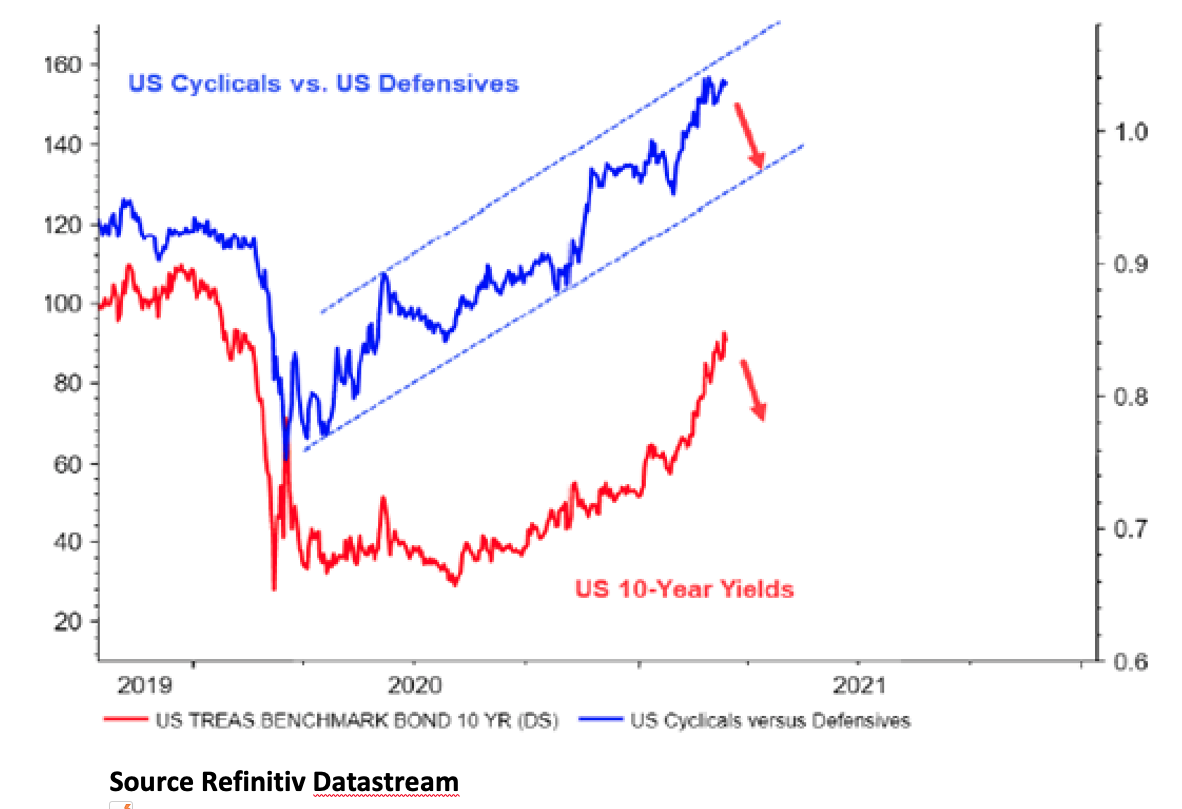
Are we embarking on a new mining "supercycle"?
A key aspect of the reflation trade is stronger commodity prices? Colourful rhetoric has emerged around this, led by brokers and speculators trying to find a story to match their reflation settings. It goes like this: Negative interest rates and excessive money supply growth create price inflation which is good for ‘hard asset’ (commodities) versus paper assets, that is, shares. There has been little investment in new mine development in the aftermath of the mining bust, leaving markets undersupplied in the medium term, and of course, we have the excitement around the green revolution and EV’s in particular.
We are seeing an upswing in demand for commodities as advanced economies report nominal growth approaching 10% this year, but this is a typical though admittedly strong recovery in the business cycle.
The two prior mining booms in the modern era have been associated with a step-change in the demand curve as Japan and China have industrialised. We do not have this on the horizon. If anything, the intensity of China’s commodities consumption is easing.
Some niche commodity segments look undersupplied in the medium term as EV penetration builds - Lithium, Cobalt, and rare earth metals in particular - but these are niche segments. The incremental demand for industrial metals- copper and nickel should be adequately supplied by new mine supply (for copper) and new processing methods (for nickel).
In bulk commodities it is true: no one in their right mind is investing in coal outside of China, which consumes more than half the world’s coal.
In Iron ore, steel demand will moderate further in the medium term as China pivots away from capital formation. In line with this, China’s Ministry of Industry and Information Technology (MIIT) has called for lower crude steel production this year to curb emission (steel accounts for 15% of emissions).
The supercycle thesis lines up nicely with the reflation thematic that is driving markets. There is no fundamental basis for the elevated prices we are seeing across the commodities spectrum, markets are simply not that tight.
This does not mean the thematic does not persist – in the medium term, it probably will. As activity is normalising in advanced economies in H2’2021 and Chinese growth slows, the National People’s Congress set a disappointing growth target for this year (China always acts counter-cyclically to western economies); investors are likely to lose confidence in sky-high commodity prices.
While we do not foresee another supercycle in mining and energy shares, they may outperform the broader share market in the medium term. The underperformance of Value and commodities versus shares more broadly in recent years does look like its due to reverse-refer to Fig 2 below. This of course can happen in two ways:
- commodities can inflate relative to shares or
- shares can deflate (fall) relative to commodities.
A bear market in shares can
deliver the same outcome.
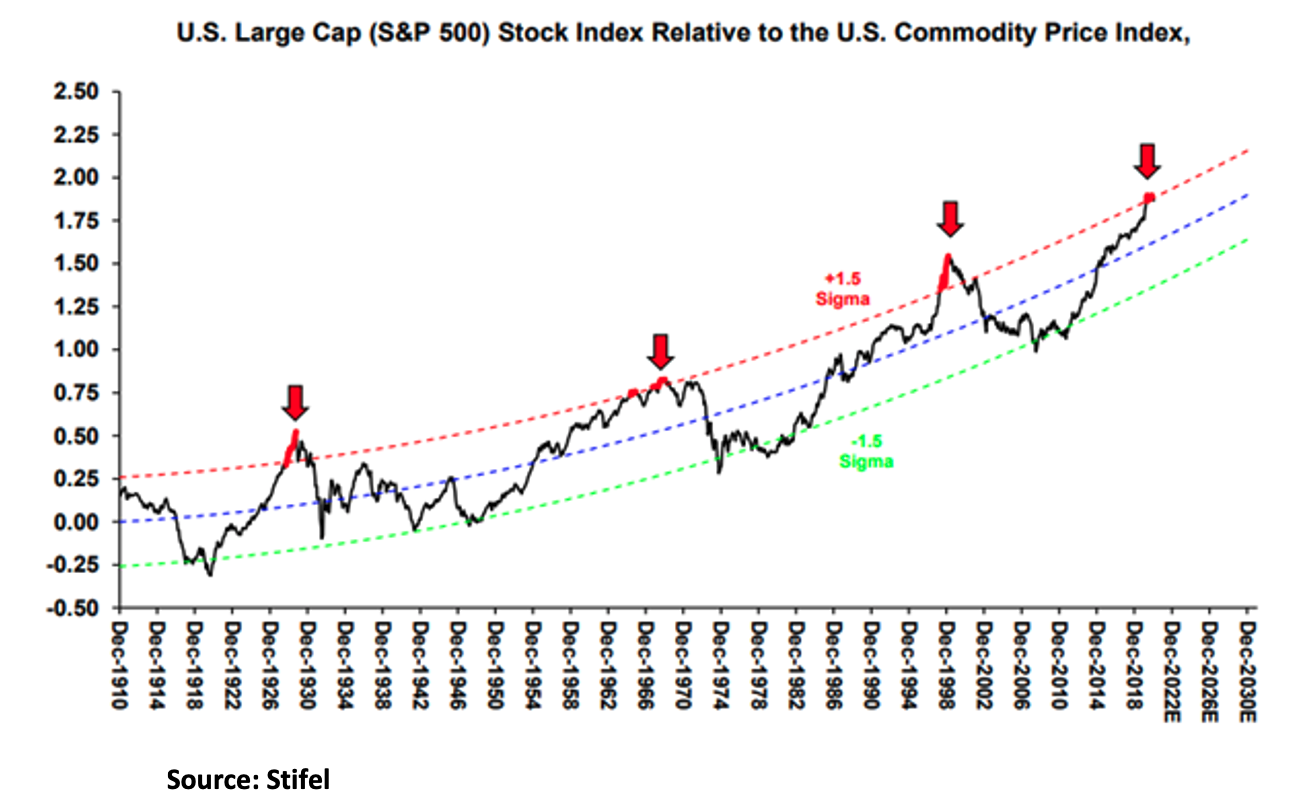
Is technology about to crash?
Technology has performed incredibly well through this bull market, now in its twelfth year, for many reasons. The digital economy has grown tremendously as households and businesses have embraced technology. This shift has clearly accelerated with the health crisis, as discussed above.
While in some sectors, demand has been brought forward by the crisis, such as with e-commerce, generally, the acceleration in the digital economy will continue. COVID was a great awakening to the benefits of a digital economy, that message has not been lost on a single business we speak too. Those that lead in technology will invest to stay in front and the slow adopters caught wanting through the crisis will spend to catch up.
There is still tremendous momentum in each of the enablers of technology adoption: e-commerce; Cloud and SaaS computing, the internet of things (connected devised), and big data to name the main ones. This has become obvious to businesses and households awash with liquidity; they will keep investing given penetration is still early for many of these services. Fig 3 below is inciteful in showing the divergence in profit growth for Tech and non-Tech sectors. It explains why Tech is a dominant sector in the US share market and how challenged our own share market is by its relative absence.
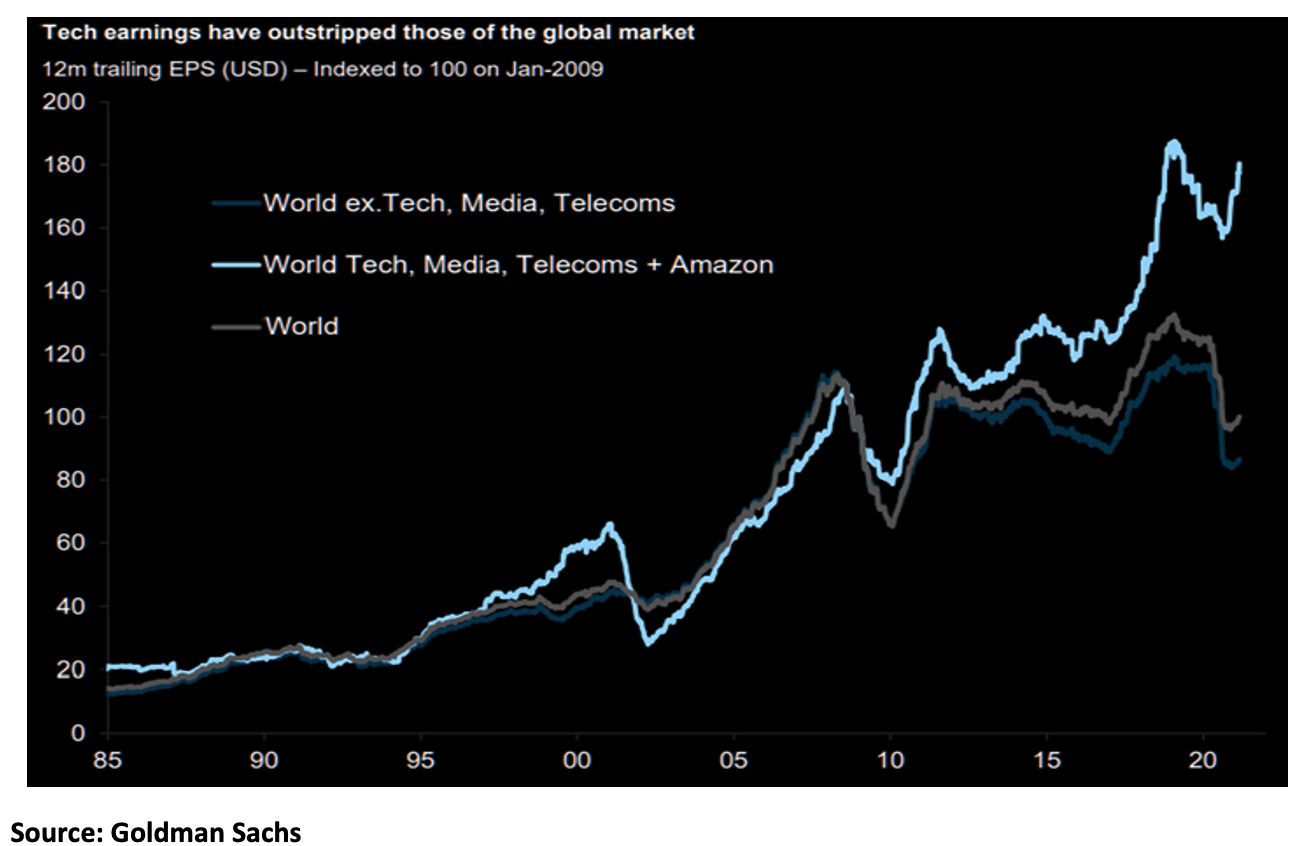
Of the two major tailwinds pushing technology shares higher – the health crisis and low interest rates – the first is abating and the second is reversing. As the fundamental drivers of technology adoption are very much intact, the sector can still perform but is unlikely to lead the way it has in recent years.
As real rates are likely to keep moving higher in the medium term, a second tech boom to complete this bull market looks less likely. The golden years of leadership from technology and growth seem for the time being behind us.
Does this cycle end in a share market bubble?
This is less likely now. Bubbles form through price-to-earnings ratio expansion as investors get overly excited around popular themes, including the ‘The Nifty fifty’ companies that led the first wave of globalisation in the 1960s; and of course, the Dot.Com phenomenon in 2000.
As interest rates are now retracing, PEs should contract rather than expand, earnings growth (EPS) will have to do the heavy lifting if shares are to move higher from here. While profits are clearly recovering from depressed levels and beating expectations, forecasts that had been slashed through the depths of the crisis and are now more reflective of the strong recovery unfolding.
We are moving through the sweet spot of the earnings cycle now where profits surprise (the second derivative of earnings revisions has peaked) it gets tougher as we move into the second half of the year.
The exuberance of the 1920s bubble can be traced back to the Genoa conference of 1922 when western leaders restructured the gold standard. Instead of redeeming each other's currencies in gold, they elected instead to hold foreign currencies in reserve in lieu of gold. A consequence of course was the creation of additional credit, which fuelled asset inflation, culminating in the Great crash of 1929.
If ever there was a catalyst for a bubble, then surely zero interest rates and money printing would constitute one. While credit is abundant and readily available, we are not seeing the sort of credit expansion that has inflated bubbles in the past. This may still emerge though if current liquidity settings are maintained for too long.
For the reasons laid out above, the two principal themes that may have led to a broader market bubble in commodities and/or technology are looking less likely now. Despite all the talk of bubbles, they are extremely rare- we have had just two in the US share market in the last hundred years, the 1920’s and in 2000.
In Fig 4 below using
a CAPE P/E ratio you can see those two episodes. We came close in the 1960’s with the ‘Nifty
50’ and again today. Using this measure, we're not technically in a bubble
YET.
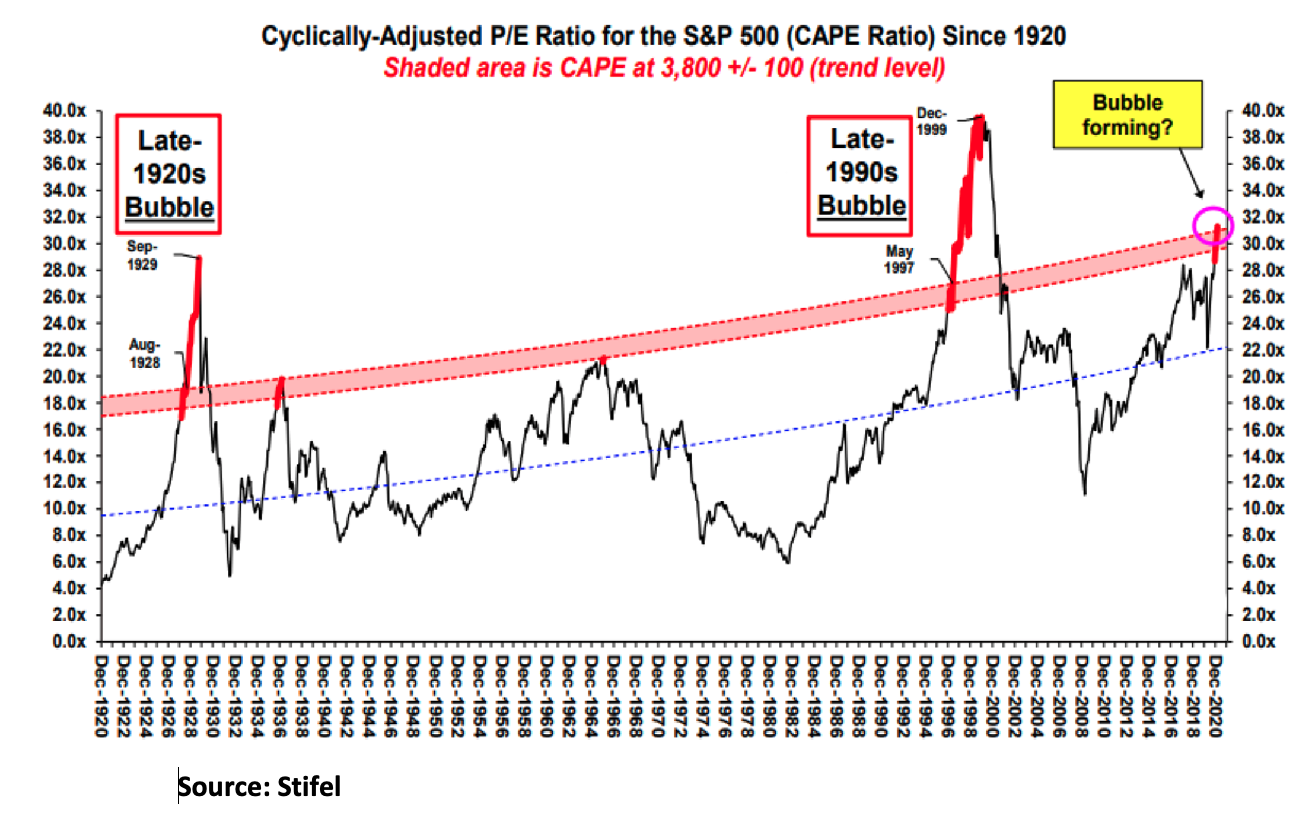
This does not mean we want to have bubbles emerge in certain sectors of the market. We are clearly seeing this already in cryptocurrencies, certain commodities, green energy, and disruptive technologies (ARKK:US), where we have well-formed price bubbles.
It is important to monitor the development of these price signals as they are indicators of when the broader market may turn. Bitcoin as an example has led all-important tactical and strategic tops in risk markets since 2012! Right now, the parabolic shape of the cryptocurrency looks like a major top is not far away. Similarly, keep an eye on other emerging and disruptive technologies where we have bubbles in place. (ARKK:US, TSLA, LIT). As investors abandon these themes, we will move closer to a major market top.
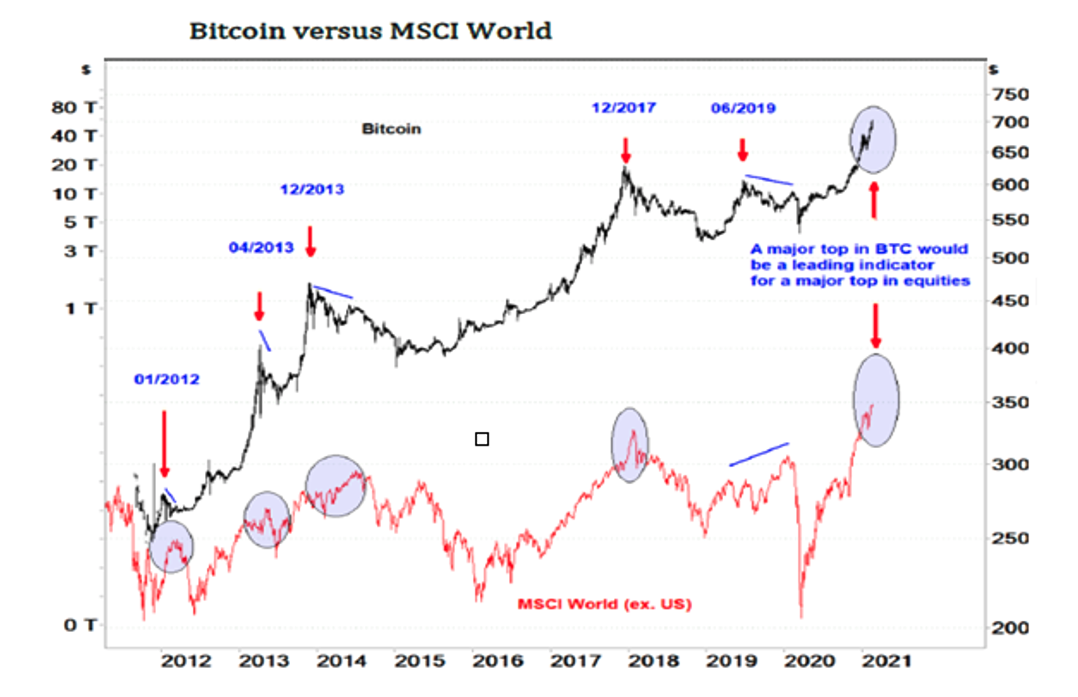
We have all the ingredients in place for a late-cycle bull market. Stretched valuations Fig 4 exuberance (bubbles) in popular segments; the full commitment of traders (cash allocations are low and net length amongst hedge funds is very high)- retail investors are back (retail volumes are at a 20-year high); and little downside protection (CBOE Put/Call ratio also at a 20-year low).
Once everyone is all in, unhedged and fully committed, all we need is a shift in the policy settings to complete this cycle. The 1920 bubble burst when the newly formed Federal Reserve started raising rates in August 1929, precipitating the crash two months later. This cycle will end in a similar manner, maybe not with a crash but a good old fashion bear market at least.
This brings me to my key concern around the outlook. The events of the last year have reminded us of how uncertain the future can be. The contrast confidence of investors in future policy settings is palpable. We have our own RBA Governor Lowe, indicating interest rates will stay at the zero bound until 2024! Ditto with the US Federal Reserve. They have created a rod for their backs. I also hear strategists confidently predict a tapering of QE starting in one year, which means we want to see rates increase for a further 2 years once QE is fully unwound.
While inflation has been absent in recent years, we have shifted into a very different environment. As Larry Summers recently observed, with growth rocketing along at 10% nominally and loads of stimulus still to come, the output gap that policymakers are relying on can ‘snap shut’ very quickly. The under-utilisation of resources is in certain (largely unproductive) sectors only, not widespread. Take the recent NFIB Small Business Job Openings ‘Hard to Fill Index’ survey as an example, it just hit its highest level in 50 YEARS. This is a very dangerous environment to be anchoring to longer-term forecasts.
For the post-financial crisis period, growth in western economies was sluggish and policy settings were very accommodative to support growth. This was the ‘Goldilocks economy’ that investors have revelled in as interest rates have shifted lower and asset prices have inflated.
Right now, Goldilocks’ bike is moving very fast, she is developing a speed wobble and heading for a brick wall- (the output gap -snaps shut). The outlook is very uncertain, the economy is out of equilibrium and rebalancing violently. This is a very difficult economy for policymakers to manage, leaving us far more susceptible to a policy mistake - the risk premium should be high reflecting this. Instead, exuberance prevails for investors across most asset classes, which should make you very nervous.
As we move into next year, I suspect western economies will be running too hot, capacity in product and service sectors will have tightened considerably (snapped shut), and policymakers will be forced to tighten more quickly than markets will allow. Leverage is much higher, the tolerance for higher interest rates much diminished and asset markets that are grossly overvalued will move into a long over-due bear market.
Not already a Livewire member?
Sign up today to get free access to investment ideas and strategies from Australia’s leading investors.
2 topics

